Interactive Marketing: Analysis of Theories & Social Media Impact
VerifiedAdded on 2023/06/09
|10
|2127
|192
Essay
AI Summary
This essay explores the effect of social media on people's daily lives and its power to revolutionize them, using different theories and a structural literature review. It analyzes three theories: switching behavior, social power, and media richness theory, based on relevant articles. The analysis identifies similarities in the increasing impact of social media, differences in the use of 'filter blogs,' and the cause-effect relationship of social media on business. It discusses the application of blogs and social media for driving traffic, increasing brand awareness, and developing customer relationships, particularly in the context of multinational companies like Samsung Real-estate. The essay concludes that the three theories are greatly affected by the power of blogs and social media, with information and communication technology integrating with business for knowledge production and societal influence.
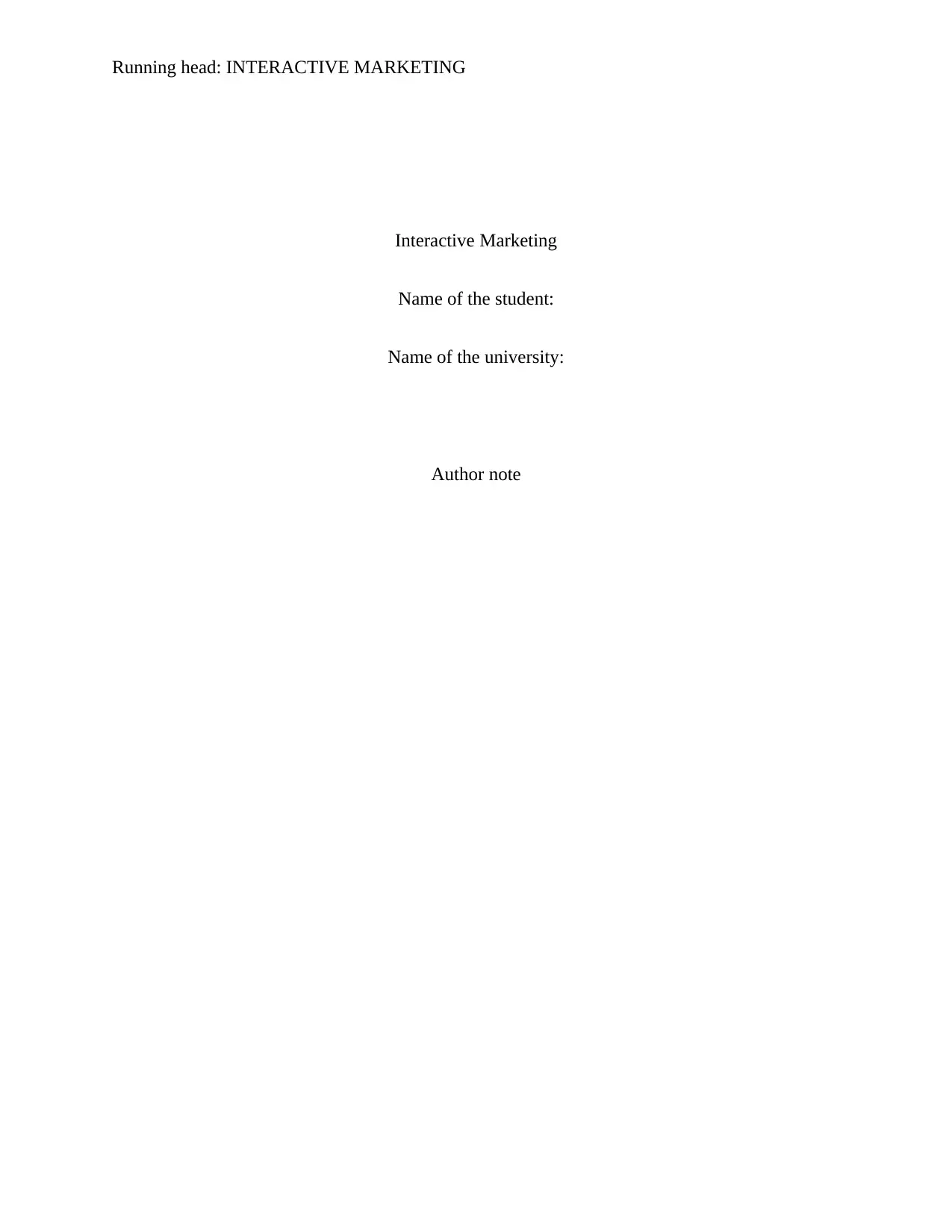
Running head: INTERACTIVE MARKETING
Interactive Marketing
Name of the student:
Name of the university:
Author note
Interactive Marketing
Name of the student:
Name of the university:
Author note
Paraphrase This Document
Need a fresh take? Get an instant paraphrase of this document with our AI Paraphraser
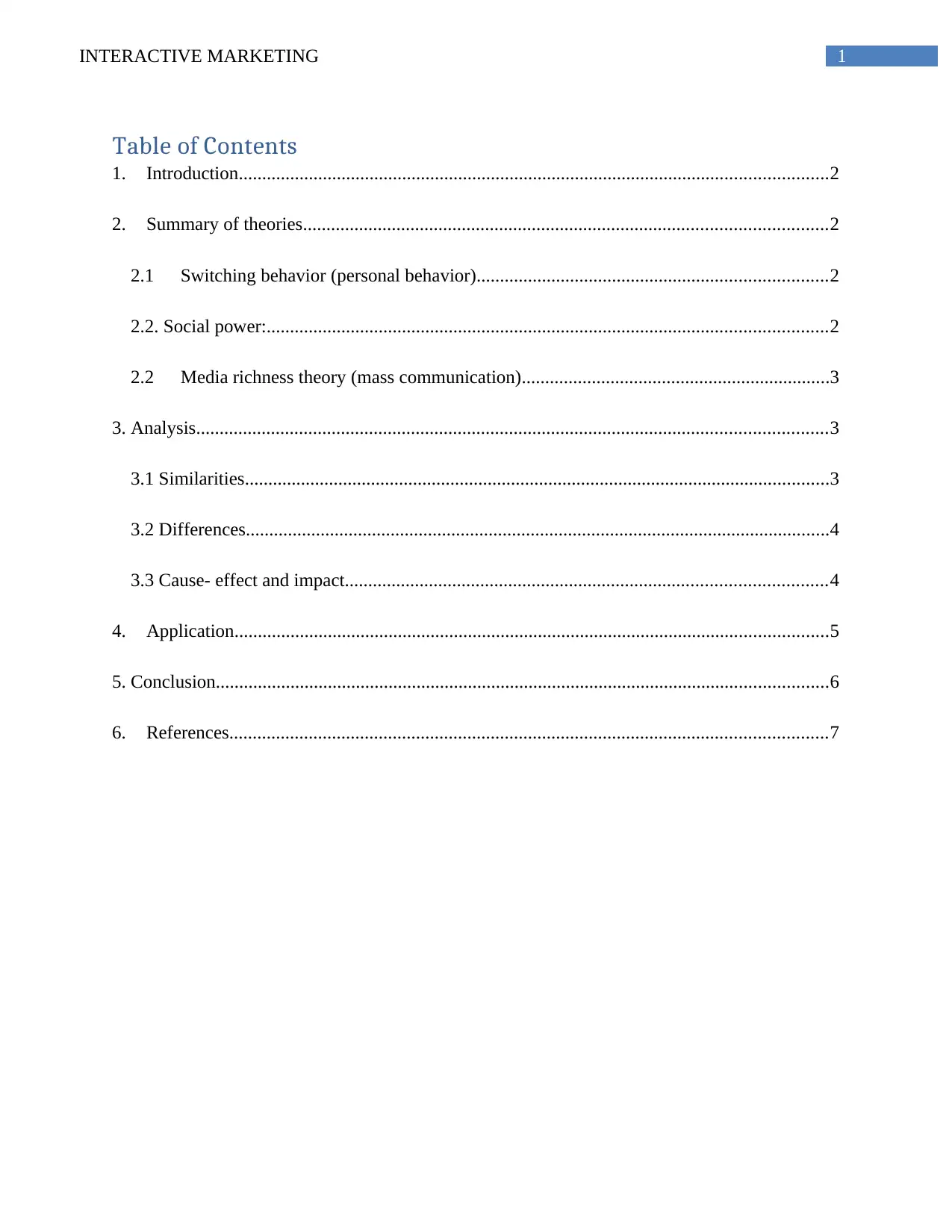
1INTERACTIVE MARKETING
Table of Contents
1. Introduction..............................................................................................................................2
2. Summary of theories................................................................................................................2
2.1 Switching behavior (personal behavior)...........................................................................2
2.2. Social power:........................................................................................................................2
2.2 Media richness theory (mass communication)..................................................................3
3. Analysis.......................................................................................................................................3
3.1 Similarities.............................................................................................................................3
3.2 Differences.............................................................................................................................4
3.3 Cause- effect and impact.......................................................................................................4
4. Application...............................................................................................................................5
5. Conclusion...................................................................................................................................6
6. References................................................................................................................................7
Table of Contents
1. Introduction..............................................................................................................................2
2. Summary of theories................................................................................................................2
2.1 Switching behavior (personal behavior)...........................................................................2
2.2. Social power:........................................................................................................................2
2.2 Media richness theory (mass communication)..................................................................3
3. Analysis.......................................................................................................................................3
3.1 Similarities.............................................................................................................................3
3.2 Differences.............................................................................................................................4
3.3 Cause- effect and impact.......................................................................................................4
4. Application...............................................................................................................................5
5. Conclusion...................................................................................................................................6
6. References................................................................................................................................7
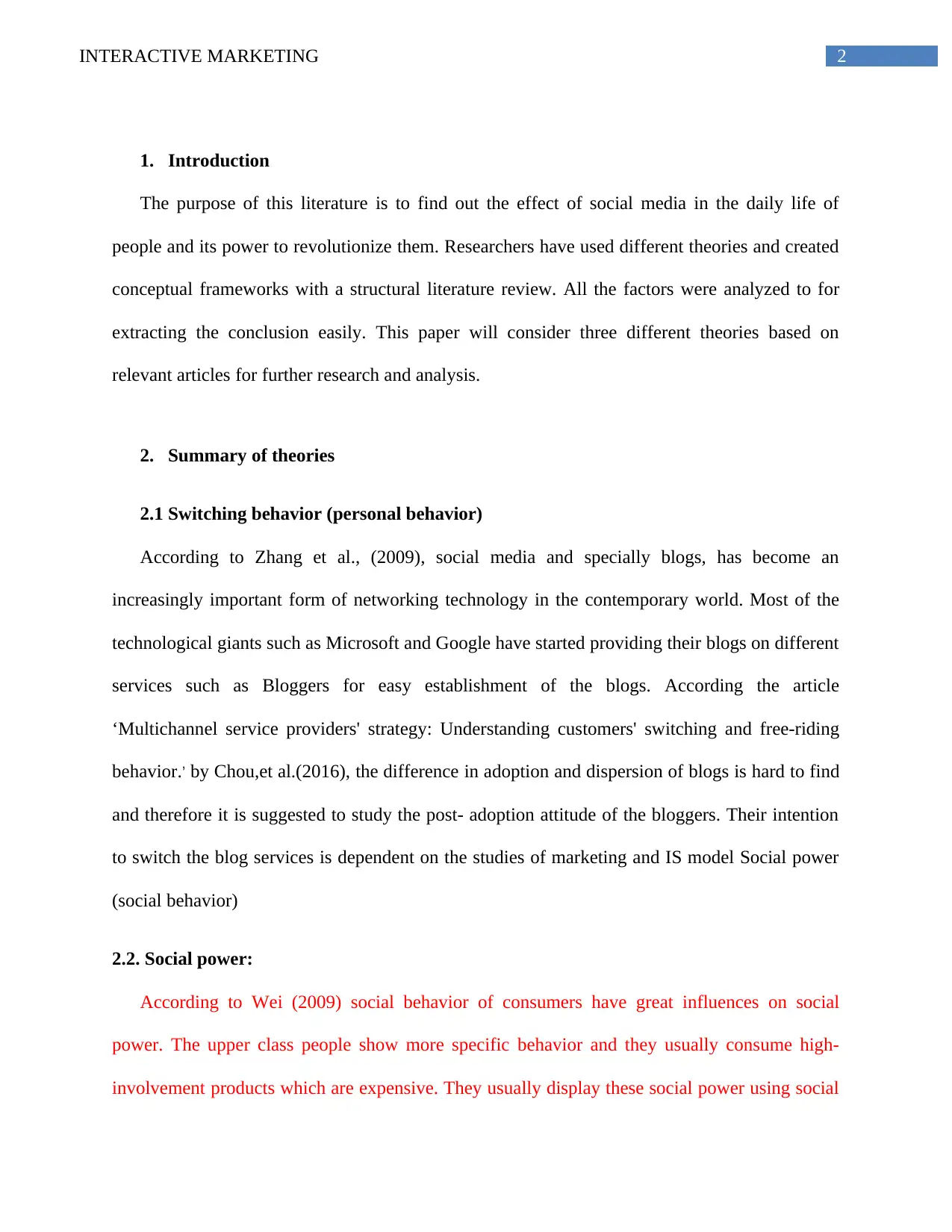
2INTERACTIVE MARKETING
1. Introduction
The purpose of this literature is to find out the effect of social media in the daily life of
people and its power to revolutionize them. Researchers have used different theories and created
conceptual frameworks with a structural literature review. All the factors were analyzed to for
extracting the conclusion easily. This paper will consider three different theories based on
relevant articles for further research and analysis.
2. Summary of theories
2.1 Switching behavior (personal behavior)
According to Zhang et al., (2009), social media and specially blogs, has become an
increasingly important form of networking technology in the contemporary world. Most of the
technological giants such as Microsoft and Google have started providing their blogs on different
services such as Bloggers for easy establishment of the blogs. According the article
‘Multichannel service providers' strategy: Understanding customers' switching and free-riding
behavior.’ by Chou,et al.(2016), the difference in adoption and dispersion of blogs is hard to find
and therefore it is suggested to study the post- adoption attitude of the bloggers. Their intention
to switch the blog services is dependent on the studies of marketing and IS model Social power
(social behavior)
2.2. Social power:
According to Wei (2009) social behavior of consumers have great influences on social
power. The upper class people show more specific behavior and they usually consume high-
involvement products which are expensive. They usually display these social power using social
1. Introduction
The purpose of this literature is to find out the effect of social media in the daily life of
people and its power to revolutionize them. Researchers have used different theories and created
conceptual frameworks with a structural literature review. All the factors were analyzed to for
extracting the conclusion easily. This paper will consider three different theories based on
relevant articles for further research and analysis.
2. Summary of theories
2.1 Switching behavior (personal behavior)
According to Zhang et al., (2009), social media and specially blogs, has become an
increasingly important form of networking technology in the contemporary world. Most of the
technological giants such as Microsoft and Google have started providing their blogs on different
services such as Bloggers for easy establishment of the blogs. According the article
‘Multichannel service providers' strategy: Understanding customers' switching and free-riding
behavior.’ by Chou,et al.(2016), the difference in adoption and dispersion of blogs is hard to find
and therefore it is suggested to study the post- adoption attitude of the bloggers. Their intention
to switch the blog services is dependent on the studies of marketing and IS model Social power
(social behavior)
2.2. Social power:
According to Wei (2009) social behavior of consumers have great influences on social
power. The upper class people show more specific behavior and they usually consume high-
involvement products which are expensive. They usually display these social power using social
⊘ This is a preview!⊘
Do you want full access?
Subscribe today to unlock all pages.

Trusted by 1+ million students worldwide
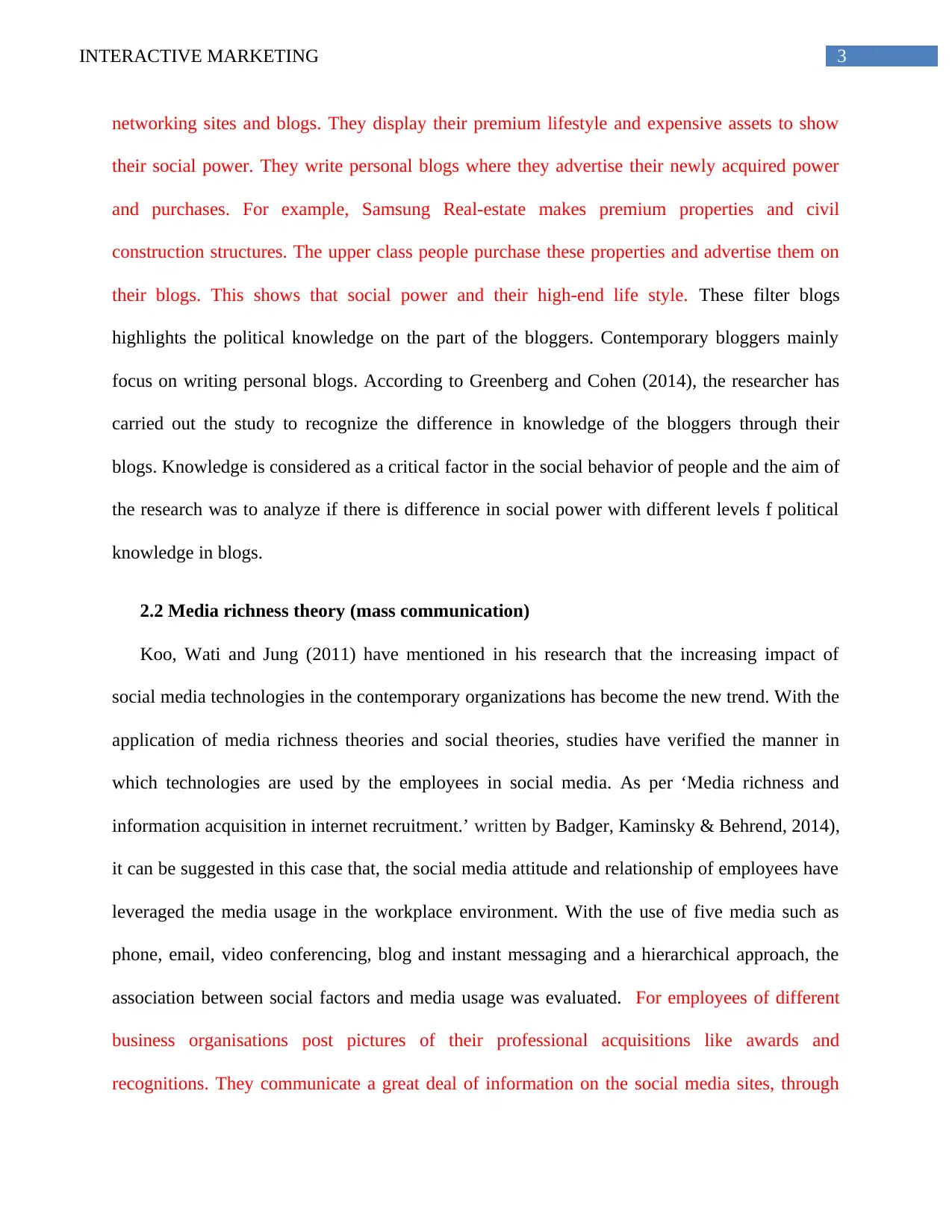
3INTERACTIVE MARKETING
networking sites and blogs. They display their premium lifestyle and expensive assets to show
their social power. They write personal blogs where they advertise their newly acquired power
and purchases. For example, Samsung Real-estate makes premium properties and civil
construction structures. The upper class people purchase these properties and advertise them on
their blogs. This shows that social power and their high-end life style. These filter blogs
highlights the political knowledge on the part of the bloggers. Contemporary bloggers mainly
focus on writing personal blogs. According to Greenberg and Cohen (2014), the researcher has
carried out the study to recognize the difference in knowledge of the bloggers through their
blogs. Knowledge is considered as a critical factor in the social behavior of people and the aim of
the research was to analyze if there is difference in social power with different levels f political
knowledge in blogs.
2.2 Media richness theory (mass communication)
Koo, Wati and Jung (2011) have mentioned in his research that the increasing impact of
social media technologies in the contemporary organizations has become the new trend. With the
application of media richness theories and social theories, studies have verified the manner in
which technologies are used by the employees in social media. As per ‘Media richness and
information acquisition in internet recruitment.’ written by Badger, Kaminsky & Behrend, 2014),
it can be suggested in this case that, the social media attitude and relationship of employees have
leveraged the media usage in the workplace environment. With the use of five media such as
phone, email, video conferencing, blog and instant messaging and a hierarchical approach, the
association between social factors and media usage was evaluated. For employees of different
business organisations post pictures of their professional acquisitions like awards and
recognitions. They communicate a great deal of information on the social media sites, through
networking sites and blogs. They display their premium lifestyle and expensive assets to show
their social power. They write personal blogs where they advertise their newly acquired power
and purchases. For example, Samsung Real-estate makes premium properties and civil
construction structures. The upper class people purchase these properties and advertise them on
their blogs. This shows that social power and their high-end life style. These filter blogs
highlights the political knowledge on the part of the bloggers. Contemporary bloggers mainly
focus on writing personal blogs. According to Greenberg and Cohen (2014), the researcher has
carried out the study to recognize the difference in knowledge of the bloggers through their
blogs. Knowledge is considered as a critical factor in the social behavior of people and the aim of
the research was to analyze if there is difference in social power with different levels f political
knowledge in blogs.
2.2 Media richness theory (mass communication)
Koo, Wati and Jung (2011) have mentioned in his research that the increasing impact of
social media technologies in the contemporary organizations has become the new trend. With the
application of media richness theories and social theories, studies have verified the manner in
which technologies are used by the employees in social media. As per ‘Media richness and
information acquisition in internet recruitment.’ written by Badger, Kaminsky & Behrend, 2014),
it can be suggested in this case that, the social media attitude and relationship of employees have
leveraged the media usage in the workplace environment. With the use of five media such as
phone, email, video conferencing, blog and instant messaging and a hierarchical approach, the
association between social factors and media usage was evaluated. For employees of different
business organisations post pictures of their professional acquisitions like awards and
recognitions. They communicate a great deal of information on the social media sites, through
Paraphrase This Document
Need a fresh take? Get an instant paraphrase of this document with our AI Paraphraser
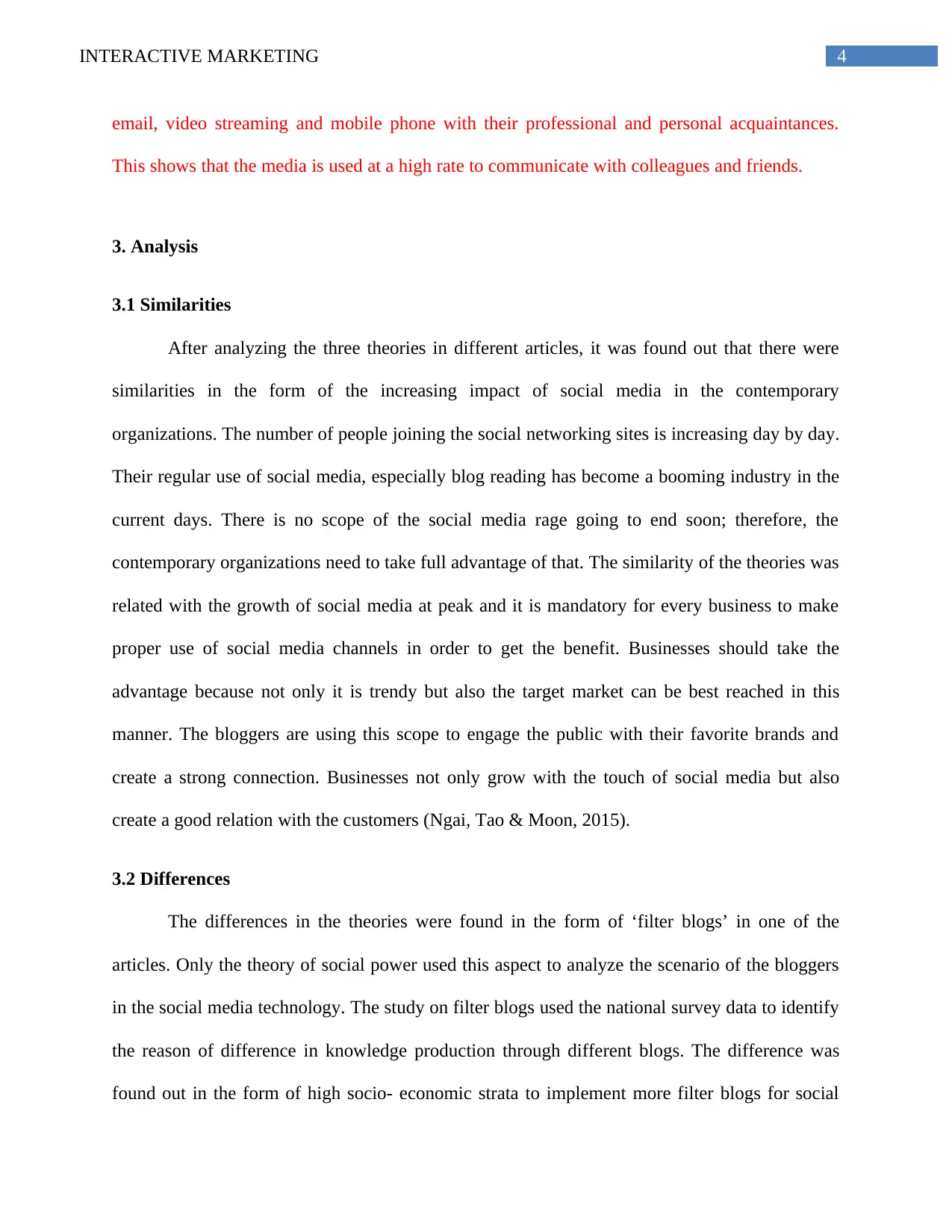
4INTERACTIVE MARKETING
email, video streaming and mobile phone with their professional and personal acquaintances.
This shows that the media is used at a high rate to communicate with colleagues and friends.
3. Analysis
3.1 Similarities
After analyzing the three theories in different articles, it was found out that there were
similarities in the form of the increasing impact of social media in the contemporary
organizations. The number of people joining the social networking sites is increasing day by day.
Their regular use of social media, especially blog reading has become a booming industry in the
current days. There is no scope of the social media rage going to end soon; therefore, the
contemporary organizations need to take full advantage of that. The similarity of the theories was
related with the growth of social media at peak and it is mandatory for every business to make
proper use of social media channels in order to get the benefit. Businesses should take the
advantage because not only it is trendy but also the target market can be best reached in this
manner. The bloggers are using this scope to engage the public with their favorite brands and
create a strong connection. Businesses not only grow with the touch of social media but also
create a good relation with the customers (Ngai, Tao & Moon, 2015).
3.2 Differences
The differences in the theories were found in the form of ‘filter blogs’ in one of the
articles. Only the theory of social power used this aspect to analyze the scenario of the bloggers
in the social media technology. The study on filter blogs used the national survey data to identify
the reason of difference in knowledge production through different blogs. The difference was
found out in the form of high socio- economic strata to implement more filter blogs for social
email, video streaming and mobile phone with their professional and personal acquaintances.
This shows that the media is used at a high rate to communicate with colleagues and friends.
3. Analysis
3.1 Similarities
After analyzing the three theories in different articles, it was found out that there were
similarities in the form of the increasing impact of social media in the contemporary
organizations. The number of people joining the social networking sites is increasing day by day.
Their regular use of social media, especially blog reading has become a booming industry in the
current days. There is no scope of the social media rage going to end soon; therefore, the
contemporary organizations need to take full advantage of that. The similarity of the theories was
related with the growth of social media at peak and it is mandatory for every business to make
proper use of social media channels in order to get the benefit. Businesses should take the
advantage because not only it is trendy but also the target market can be best reached in this
manner. The bloggers are using this scope to engage the public with their favorite brands and
create a strong connection. Businesses not only grow with the touch of social media but also
create a good relation with the customers (Ngai, Tao & Moon, 2015).
3.2 Differences
The differences in the theories were found in the form of ‘filter blogs’ in one of the
articles. Only the theory of social power used this aspect to analyze the scenario of the bloggers
in the social media technology. The study on filter blogs used the national survey data to identify
the reason of difference in knowledge production through different blogs. The difference was
found out in the form of high socio- economic strata to implement more filter blogs for social
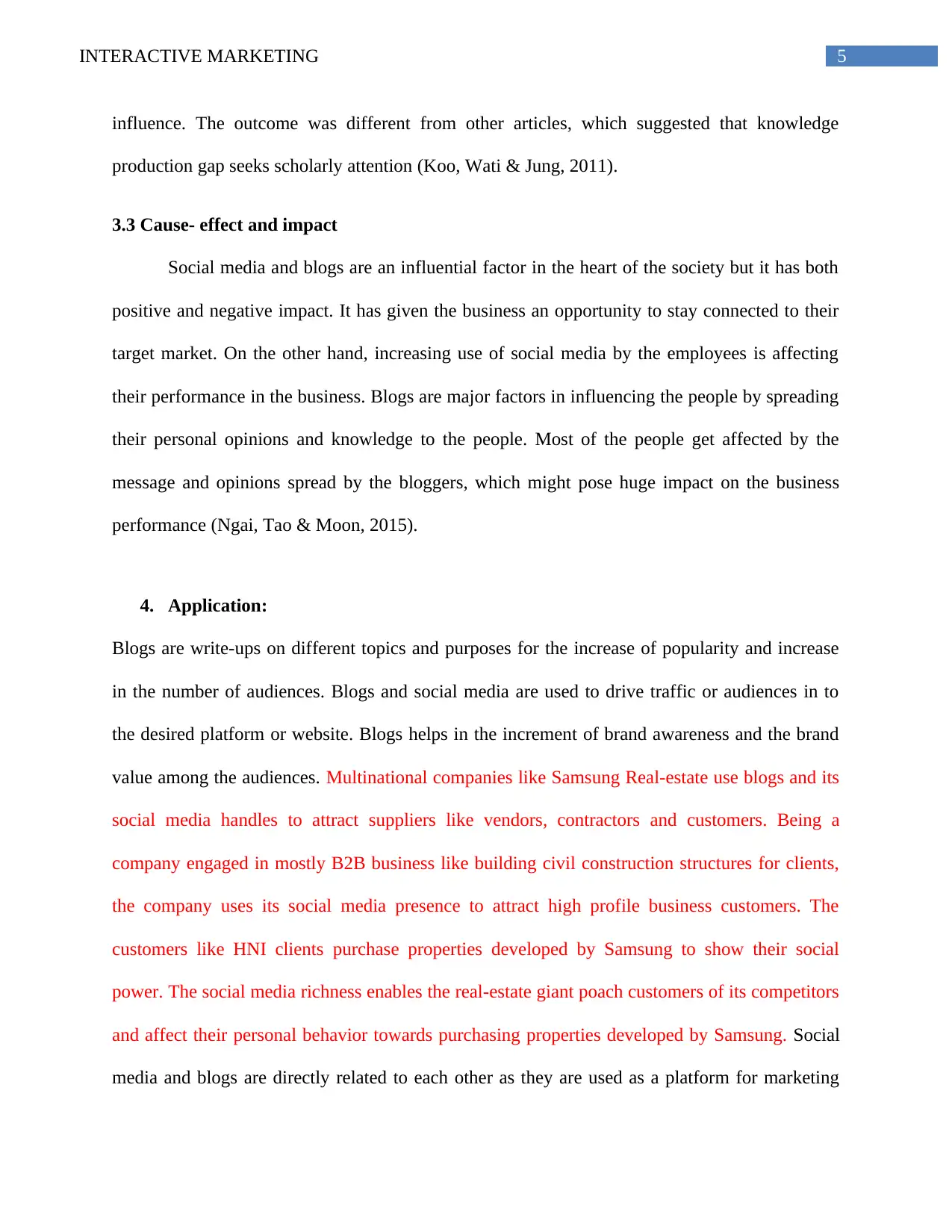
5INTERACTIVE MARKETING
influence. The outcome was different from other articles, which suggested that knowledge
production gap seeks scholarly attention (Koo, Wati & Jung, 2011).
3.3 Cause- effect and impact
Social media and blogs are an influential factor in the heart of the society but it has both
positive and negative impact. It has given the business an opportunity to stay connected to their
target market. On the other hand, increasing use of social media by the employees is affecting
their performance in the business. Blogs are major factors in influencing the people by spreading
their personal opinions and knowledge to the people. Most of the people get affected by the
message and opinions spread by the bloggers, which might pose huge impact on the business
performance (Ngai, Tao & Moon, 2015).
4. Application:
Blogs are write-ups on different topics and purposes for the increase of popularity and increase
in the number of audiences. Blogs and social media are used to drive traffic or audiences in to
the desired platform or website. Blogs helps in the increment of brand awareness and the brand
value among the audiences. Multinational companies like Samsung Real-estate use blogs and its
social media handles to attract suppliers like vendors, contractors and customers. Being a
company engaged in mostly B2B business like building civil construction structures for clients,
the company uses its social media presence to attract high profile business customers. The
customers like HNI clients purchase properties developed by Samsung to show their social
power. The social media richness enables the real-estate giant poach customers of its competitors
and affect their personal behavior towards purchasing properties developed by Samsung. Social
media and blogs are directly related to each other as they are used as a platform for marketing
influence. The outcome was different from other articles, which suggested that knowledge
production gap seeks scholarly attention (Koo, Wati & Jung, 2011).
3.3 Cause- effect and impact
Social media and blogs are an influential factor in the heart of the society but it has both
positive and negative impact. It has given the business an opportunity to stay connected to their
target market. On the other hand, increasing use of social media by the employees is affecting
their performance in the business. Blogs are major factors in influencing the people by spreading
their personal opinions and knowledge to the people. Most of the people get affected by the
message and opinions spread by the bloggers, which might pose huge impact on the business
performance (Ngai, Tao & Moon, 2015).
4. Application:
Blogs are write-ups on different topics and purposes for the increase of popularity and increase
in the number of audiences. Blogs and social media are used to drive traffic or audiences in to
the desired platform or website. Blogs helps in the increment of brand awareness and the brand
value among the audiences. Multinational companies like Samsung Real-estate use blogs and its
social media handles to attract suppliers like vendors, contractors and customers. Being a
company engaged in mostly B2B business like building civil construction structures for clients,
the company uses its social media presence to attract high profile business customers. The
customers like HNI clients purchase properties developed by Samsung to show their social
power. The social media richness enables the real-estate giant poach customers of its competitors
and affect their personal behavior towards purchasing properties developed by Samsung. Social
media and blogs are directly related to each other as they are used as a platform for marketing
⊘ This is a preview!⊘
Do you want full access?
Subscribe today to unlock all pages.

Trusted by 1+ million students worldwide
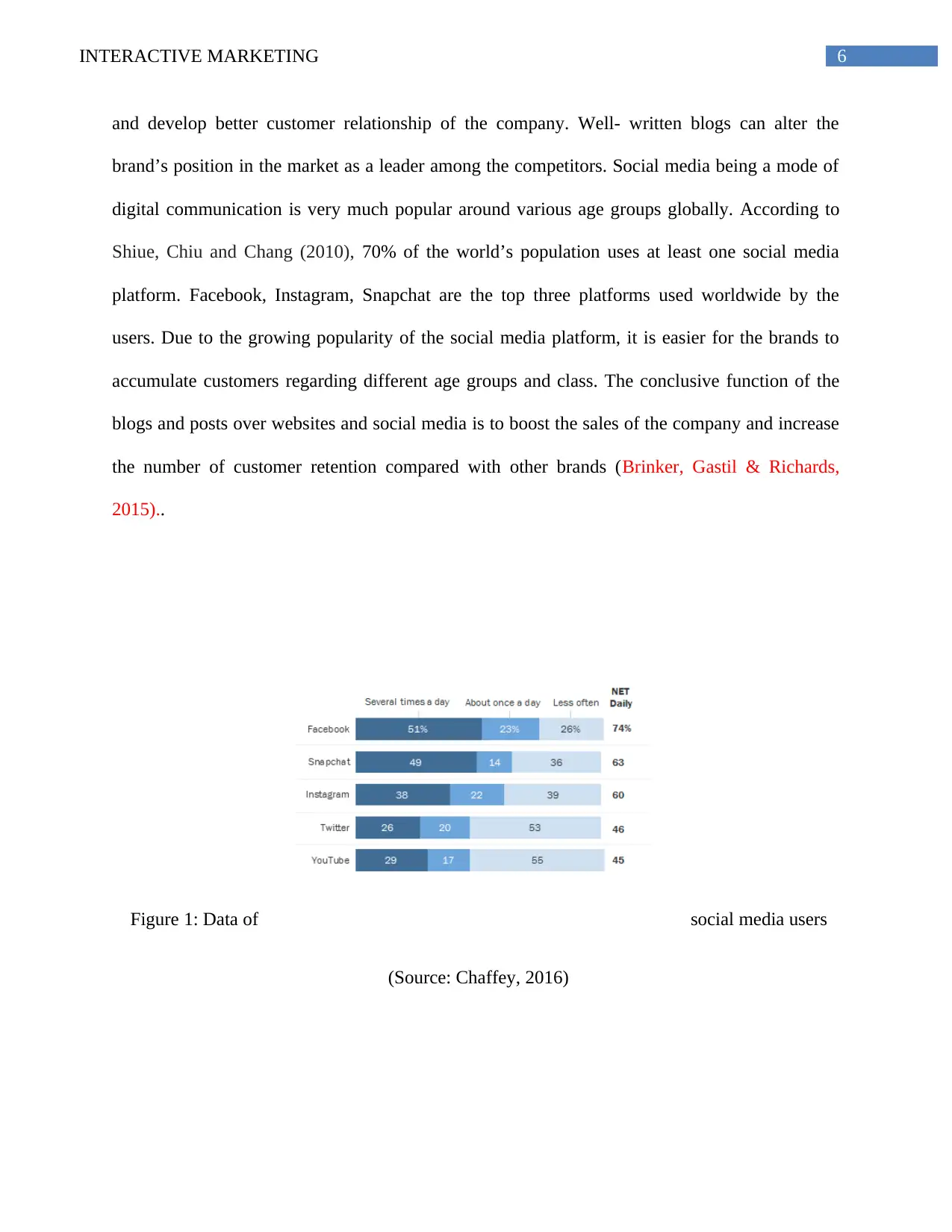
6INTERACTIVE MARKETING
and develop better customer relationship of the company. Well- written blogs can alter the
brand’s position in the market as a leader among the competitors. Social media being a mode of
digital communication is very much popular around various age groups globally. According to
Shiue, Chiu and Chang (2010), 70% of the world’s population uses at least one social media
platform. Facebook, Instagram, Snapchat are the top three platforms used worldwide by the
users. Due to the growing popularity of the social media platform, it is easier for the brands to
accumulate customers regarding different age groups and class. The conclusive function of the
blogs and posts over websites and social media is to boost the sales of the company and increase
the number of customer retention compared with other brands (Brinker, Gastil & Richards,
2015)..
Figure 1: Data of social media users
(Source: Chaffey, 2016)
and develop better customer relationship of the company. Well- written blogs can alter the
brand’s position in the market as a leader among the competitors. Social media being a mode of
digital communication is very much popular around various age groups globally. According to
Shiue, Chiu and Chang (2010), 70% of the world’s population uses at least one social media
platform. Facebook, Instagram, Snapchat are the top three platforms used worldwide by the
users. Due to the growing popularity of the social media platform, it is easier for the brands to
accumulate customers regarding different age groups and class. The conclusive function of the
blogs and posts over websites and social media is to boost the sales of the company and increase
the number of customer retention compared with other brands (Brinker, Gastil & Richards,
2015)..
Figure 1: Data of social media users
(Source: Chaffey, 2016)
Paraphrase This Document
Need a fresh take? Get an instant paraphrase of this document with our AI Paraphraser
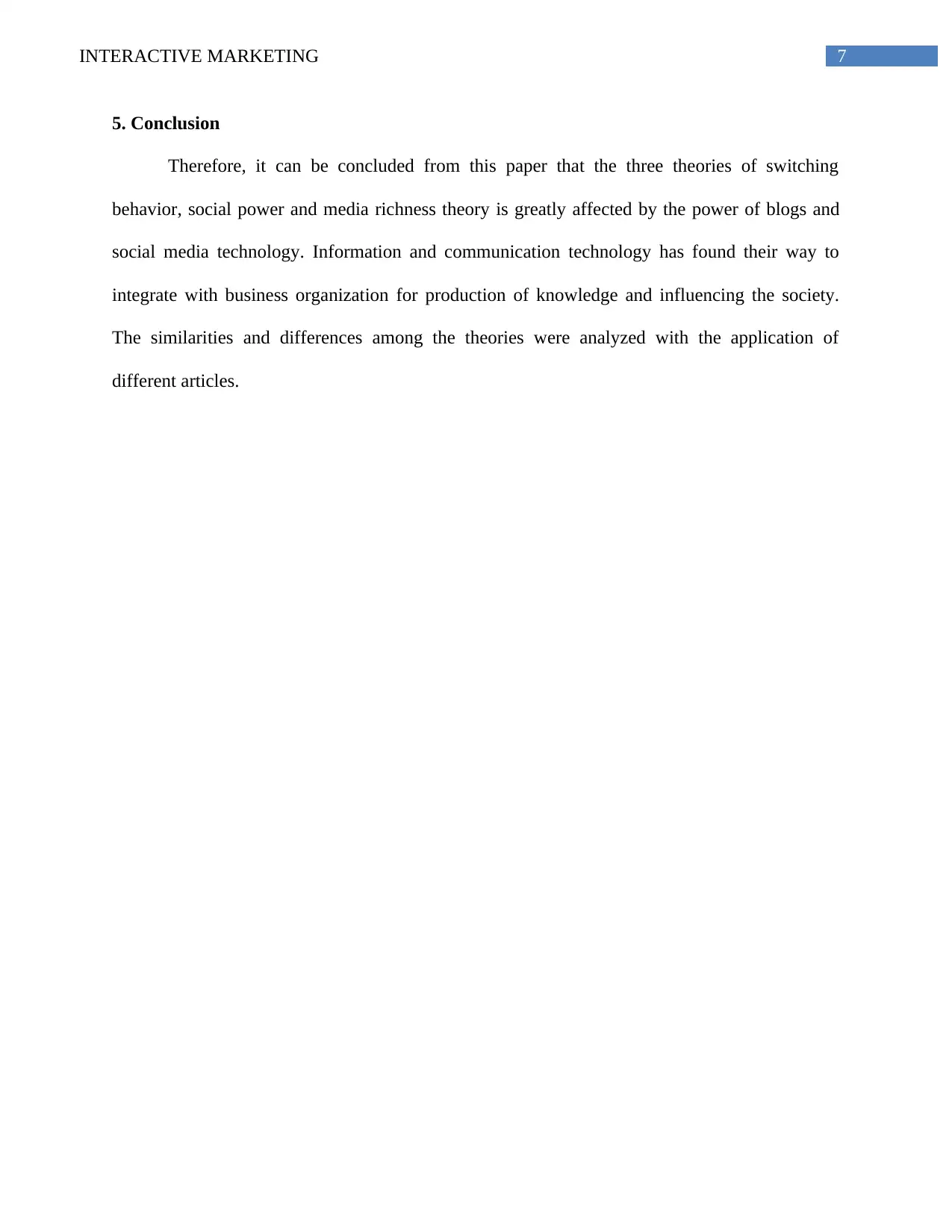
7INTERACTIVE MARKETING
5. Conclusion
Therefore, it can be concluded from this paper that the three theories of switching
behavior, social power and media richness theory is greatly affected by the power of blogs and
social media technology. Information and communication technology has found their way to
integrate with business organization for production of knowledge and influencing the society.
The similarities and differences among the theories were analyzed with the application of
different articles.
5. Conclusion
Therefore, it can be concluded from this paper that the three theories of switching
behavior, social power and media richness theory is greatly affected by the power of blogs and
social media technology. Information and communication technology has found their way to
integrate with business organization for production of knowledge and influencing the society.
The similarities and differences among the theories were analyzed with the application of
different articles.
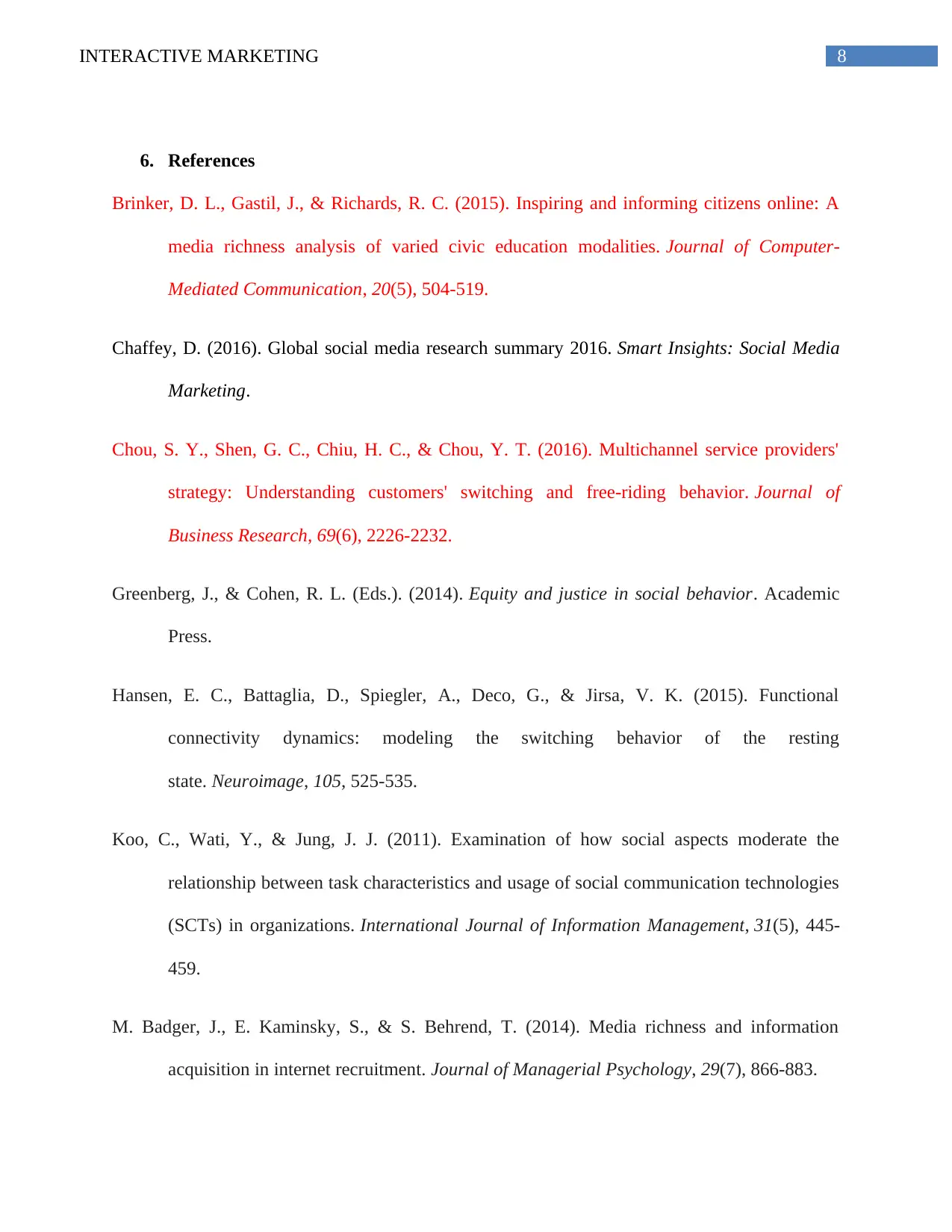
8INTERACTIVE MARKETING
6. References
Brinker, D. L., Gastil, J., & Richards, R. C. (2015). Inspiring and informing citizens online: A
media richness analysis of varied civic education modalities. Journal of Computer-
Mediated Communication, 20(5), 504-519.
Chaffey, D. (2016). Global social media research summary 2016. Smart Insights: Social Media
Marketing.
Chou, S. Y., Shen, G. C., Chiu, H. C., & Chou, Y. T. (2016). Multichannel service providers'
strategy: Understanding customers' switching and free-riding behavior. Journal of
Business Research, 69(6), 2226-2232.
Greenberg, J., & Cohen, R. L. (Eds.). (2014). Equity and justice in social behavior. Academic
Press.
Hansen, E. C., Battaglia, D., Spiegler, A., Deco, G., & Jirsa, V. K. (2015). Functional
connectivity dynamics: modeling the switching behavior of the resting
state. Neuroimage, 105, 525-535.
Koo, C., Wati, Y., & Jung, J. J. (2011). Examination of how social aspects moderate the
relationship between task characteristics and usage of social communication technologies
(SCTs) in organizations. International Journal of Information Management, 31(5), 445-
459.
M. Badger, J., E. Kaminsky, S., & S. Behrend, T. (2014). Media richness and information
acquisition in internet recruitment. Journal of Managerial Psychology, 29(7), 866-883.
6. References
Brinker, D. L., Gastil, J., & Richards, R. C. (2015). Inspiring and informing citizens online: A
media richness analysis of varied civic education modalities. Journal of Computer-
Mediated Communication, 20(5), 504-519.
Chaffey, D. (2016). Global social media research summary 2016. Smart Insights: Social Media
Marketing.
Chou, S. Y., Shen, G. C., Chiu, H. C., & Chou, Y. T. (2016). Multichannel service providers'
strategy: Understanding customers' switching and free-riding behavior. Journal of
Business Research, 69(6), 2226-2232.
Greenberg, J., & Cohen, R. L. (Eds.). (2014). Equity and justice in social behavior. Academic
Press.
Hansen, E. C., Battaglia, D., Spiegler, A., Deco, G., & Jirsa, V. K. (2015). Functional
connectivity dynamics: modeling the switching behavior of the resting
state. Neuroimage, 105, 525-535.
Koo, C., Wati, Y., & Jung, J. J. (2011). Examination of how social aspects moderate the
relationship between task characteristics and usage of social communication technologies
(SCTs) in organizations. International Journal of Information Management, 31(5), 445-
459.
M. Badger, J., E. Kaminsky, S., & S. Behrend, T. (2014). Media richness and information
acquisition in internet recruitment. Journal of Managerial Psychology, 29(7), 866-883.
⊘ This is a preview!⊘
Do you want full access?
Subscribe today to unlock all pages.

Trusted by 1+ million students worldwide
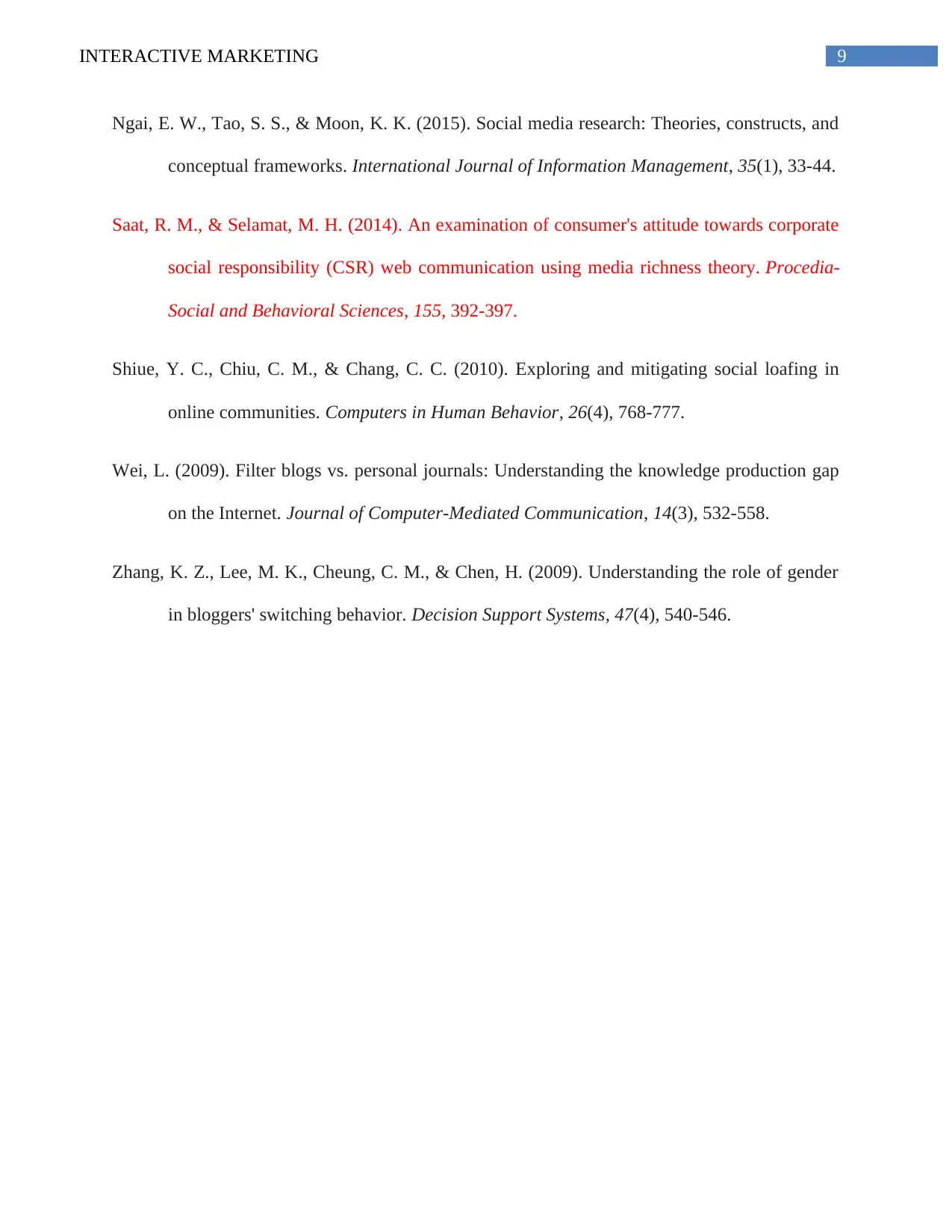
9INTERACTIVE MARKETING
Ngai, E. W., Tao, S. S., & Moon, K. K. (2015). Social media research: Theories, constructs, and
conceptual frameworks. International Journal of Information Management, 35(1), 33-44.
Saat, R. M., & Selamat, M. H. (2014). An examination of consumer's attitude towards corporate
social responsibility (CSR) web communication using media richness theory. Procedia-
Social and Behavioral Sciences, 155, 392-397.
Shiue, Y. C., Chiu, C. M., & Chang, C. C. (2010). Exploring and mitigating social loafing in
online communities. Computers in Human Behavior, 26(4), 768-777.
Wei, L. (2009). Filter blogs vs. personal journals: Understanding the knowledge production gap
on the Internet. Journal of Computer-Mediated Communication, 14(3), 532-558.
Zhang, K. Z., Lee, M. K., Cheung, C. M., & Chen, H. (2009). Understanding the role of gender
in bloggers' switching behavior. Decision Support Systems, 47(4), 540-546.
Ngai, E. W., Tao, S. S., & Moon, K. K. (2015). Social media research: Theories, constructs, and
conceptual frameworks. International Journal of Information Management, 35(1), 33-44.
Saat, R. M., & Selamat, M. H. (2014). An examination of consumer's attitude towards corporate
social responsibility (CSR) web communication using media richness theory. Procedia-
Social and Behavioral Sciences, 155, 392-397.
Shiue, Y. C., Chiu, C. M., & Chang, C. C. (2010). Exploring and mitigating social loafing in
online communities. Computers in Human Behavior, 26(4), 768-777.
Wei, L. (2009). Filter blogs vs. personal journals: Understanding the knowledge production gap
on the Internet. Journal of Computer-Mediated Communication, 14(3), 532-558.
Zhang, K. Z., Lee, M. K., Cheung, C. M., & Chen, H. (2009). Understanding the role of gender
in bloggers' switching behavior. Decision Support Systems, 47(4), 540-546.
1 out of 10
Related Documents
Your All-in-One AI-Powered Toolkit for Academic Success.
+13062052269
info@desklib.com
Available 24*7 on WhatsApp / Email
![[object Object]](/_next/static/media/star-bottom.7253800d.svg)
Unlock your academic potential
Copyright © 2020–2025 A2Z Services. All Rights Reserved. Developed and managed by ZUCOL.





